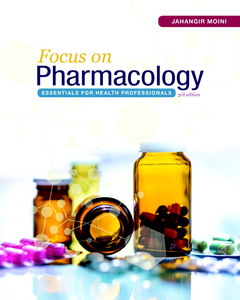Description
Focus on Pharmacology (3rd Ed.)
Essentials for Health Professionals
Author: Moini Jahangir
Language: English
Subject for Focus on Pharmacology:
784 p. · 21.5x27.5 cm · Paperback
Description
/li>Contents
/li>Biography
/li>Comment
/li>
A focused, teach-and-test approach to learning pharmacology
Focus on Pharmacology: Essentials for Health Professionalshelps students learn pharmacology by presenting small amounts of information and then offering opportunities for readers to apply what they?ve learned through a variety of exercises. Designed specifically for allied health students, early chapters lay the groundwork for learning pharmacology by introducing its history, legal and ethical principles, drug administration techniques, essential math, calculations, and medication errors. Subsequent chapters offer a structured presentation of the drugs intended to treat specific body systems and associated disorders.
Each drug chapter starts with a concise review of anatomy and physiology, providing a foundation for understanding drug actions and uses. Pharmacologic principles are then presented in a consistent and easy-to-follow format, using clearly identifiable question-headings that help students focus on need-to-know drug information. Pediatric and geriatric pharmacotherapies are covered in detail, as are substance abuse, antibiotics, and other drug categories. Updated with the latest drug information and featuring seven new chapters, the Third Edition?s focused, teach-and-test approach blends concise content with an engaging learning process to help students better retain essential information.
For even more practice and review opportunities pair Focus on Pharmacology with the completely revised and expanded Student Workbook. The Workbook (ISBN-10: 0134525299 / ISBN-13: 9780134525297) contains many different types of review questions, including multiple-choice, fill-in-the-blank, true/false, and critical-thinking.
Unit 1: General Principles
1. Introduction to Pharmacology
2. Pharmacodynamics
3. Pharmacokinetics
4. Drug Toxicity Pharmacogenomics
5. Law and Ethics of Medications
6. Terminology, Abbreviations, and Dispensing Prescriptions
7. Administration of Medications
Unit 2: Mathematics and Dosage Calculations
8. Principles of Math in Medicine
9. Measurement Systems and Their Equivalents
10. Adult and Pediatric Dosage Calculations
11. Medication Errors and Prevention
Unit 3: Drug Effects on Multiple Systems
12. Nutritional Aspects of Pharmacology
13. Dietary Supplements and Alternative Therapies
14. Toxicology
15. Substance Abuse and Misuse
16. Antibacterial Agents
17. Antiviral Agents
18. Antifungal Agents
19. Antiprotozoal Agents
20. Vaccines and Immunoglobulins
21. Analgesic, Antipyretic, and Anti-Inflammatory Drugs
22. Antineoplastic Agents
Unit 4: Drug Effects on Specific Systems
23. Drugs Used to Treat Central Nervous System Conditions
24. Drugs Used to Treat Autonomic Nervous System Conditions
25. Anesthetic Agents
26. Drugs Used to Treat Skin Conditions
27. Drugs Used to Treat Cardiovascular Conditions
28. Drugs Used to Treat Vascular Conditions
29. Drugs Used to Treat Hyperlipidemia and Related Conditions
30. Anticoagulants
31. Drugs Used to Treat Fluid and Electrolyte Imbalances
32. Drugs Used to Treat Endocrine Conditions
33. Drugs Used to Treat Reproductive Conditions
34. Drugs Used to Treat Gastrointestinal Conditions
35. Drugs Used to Treat Respiratory Conditions
36. Drugs Used to Treat Musculoskeletal Conditions
37. Drugs Used to Treat Eye Conditions
Unit 5: Special Populations
38. Drugs Used to Treat Geriatric Patients
39. Drugs Used to Treat Pediatric Patients
40. Drugs Used to Treat Pregnant Patients
Glossary
Appendices
Jahangir Moini, MD, MPH, was Assistant Professor at Tehran University School of Medicine for 9 years, teaching medical and allied health students. The author was also a Professor (for 24 years) and Director (for 15 years) of allied health programs at Everest University. He was Brevard County Epidemiologist and Biological Scientist for 18 years. Dr. Moini was also Physician Liaison for the American Association of Medical Assistants (AAMA) in Florida, and an Advisory Member of NACCAS. He is now a Professor of Science and Health at Eastern Florida State College in Palm Bay, Florida, and a member of their book selection and nursing student selection committees.
Dr. Moini is actively involved in teaching and helping students prepare for service in various health professions. He has been a published author of 18 allied health books since 1999.
A focused, teach-and-test approach to learning pharmacology
Provides fast access to the knowledge that matters most through a structured presentation of drugs intended to treat specific body systems and associated disorders.
A concise review of anatomy and physiology gives students a strong foundation for understanding the actions, effects, and uses of each drug.
Pharmacologic principles are presented in a consistent and easy-to-follow format using clearly identifiable question-headings that help students focus on key points about drugs and drug classes, including “How do they work?” “How are they used?” “What are the adverse effects?” “What are the contradictions and interactions?” “What should patients know?”
Makes learning pharmacology more engaging and interactive using a proven teach-and-test approach. The text presents small amounts of information and then quickly challenges students with applying what they’ve just learned using three sets of exercises: strategically placed in-chapter Apply Your Knowledge questions; end-of-chapter Practical Scenarios with critical-thinking questions; and end-of-unit Checkpoint Reviews that reflect the formats of most certifying and licensing exams by including multiple-choice and essay questions.
UPDATED: Gives students complete, up-to-date reference material for both study and practice with drug dosing information. Each drug chapter includes up-to-date tables of all drugs discussed in each chapter, arranged by classes and formatted to include generic and trade names, adult dosing, and route of administration.
Prepares students to recognize the unique care requirements of special populations—including pediatri
These books may interest you

Focus on pharmacology (2nd ed ) 113.67 €



